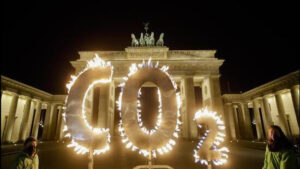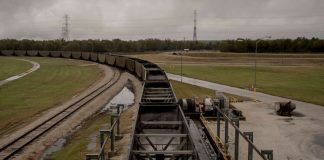JUNE 7, 2022

Activists of the environment organisation Greenpeace protest with CO2 letters illuminated with flames in front of the Brandenburg Gate against the climate crisis in Berlin, Germany, on May 6, 2021. (AP/FILE)
NEW DELHI: Carbon dioxide (CO2) measured at National Oceanic and Atmospheric Administration (NOAA’s) Mauna Loa Atmospheric Baseline Observatory peaked for 2022 at 421 parts per million in May. The World Meteorological Organisation (WMO) on Monday said CO2 levels are more than 50% higher than the pre-industrial levels.
The CO2 concentrations in the atmosphere are in territory which has not been experienced for millions of years, scientists from NOAA and at the Scripps Institution of Oceanography, University of California San Diego announced on June 3.
NOAA’s measurements of carbon dioxide at the mountaintop observatory on Hawaii’s Big Island averaged 420.99 parts per million (ppm), an increase of 1.8 ppm over 2021. Scientists at Scripps, which maintains an independent record, calculated a monthly average of 420.78 ppm.
“The science is irrefutable: humans are altering our climate in ways that our economy and our infrastructure must adapt to. We can see the impacts of climate change around us every day. The relentless increase of carbon dioxide measured at Mauna Loa is a stark reminder that we need to take urgent, serious steps to become a more Climate Ready Nation,” said NOAA administrator Rick Spinrad.
CO2 levels are now comparable to the Pliocene Climatic Optimum, between 4.1 and 4.5 million years ago, when they were close to, or above 400 ppm. During that time, sea levels were between 5 and 25 metres higher than today’s offsite link, high enough to drown many of the world’s largest modern cities. Temperatures then averaged 7 degrees Fahrenheit higher than in pre-industrial times, and studies indicate that large forests occupied today’s Arctic tundra.
CO2 emissions come from burning fossil fuels for transportation and electricity generation, cement manufacturing, deforestation, agriculture and many others. Along with other greenhouse gases, CO2 traps heat radiating from the planet’s surface that would otherwise escape into space, causing the planet’s atmosphere to warm steadily.
UN climate change conference begins
The United Nations Bonn climate change conference opened on Monday where governments are expected to discuss mitigation, adaptation, support to developing countries – particularly finance – and loss and damage. It will also lay down the agenda for COP 27 to be held in Sharm El-Sheikh.
“We urgently require political-level interventions and decisions in each of these areas in order to achieve a balanced package. Doing so will send a clear message to the world that we are headed in the right direction. Because the world is going to have one question in Sharm El-Sheikh: what progress have you made since Glasgow?” UN Climate Change executive secretary Patricia Espinosa said on Monday.
On day 1, there was a delay in adopting two issues in the provisional agenda of the Subsidiary Bodies (SBs) under the UN Framework Convention on Climate Change (UNFCCC). These issues were the global goal on adaptation (GGA) and the Glasgow Dialogue on loss and damage, two issues of priority for developing countries, the Third World Network (TWN), an international research and advocacy organisation said on Tuesday.
The need for balance in the treatment of adaptation and mitigation was stressed several times by many developing countries and their groupings. While the GGA agenda item was eventually adopted as an additional agenda to be considered by Parties, the agenda item on the Glasgow Dialogue on loss and damage was kept in abeyance, TWN said.
The ‘Glasgow-Sharm El-Sheikh work programme on the GGA’ was established last year. During several meetings held before the official opening of the Bonn conference, Like Minded Developing Countries (LMDC), a grouping of developing countries requested that it be included in the Bonn meeting agenda. Developed countries however were not in favour of the proposal, TWN said.
10-member Indian delegation at Bonn conference
The global goal on adaptation aims to provide a system for tracking and assessing countries’ progress on adaptation actions and providing adaptation finance. During an informal briefing for journalists by union environment ministry on Tuesday, a senior official said: “Adaptation finance should be equal to mitigation finance. The developed nations do not want to invest in adaptation because the return on investments is low. But adaptation is a matter of existence for island nations and many developing countries. Going forward finance for adaptation and loss and damage will be very important and India will take this forward.”
A delegation of 10 officials from India are in Bonn for the negotiations, the official said.
He added that India will be submitting its updated nationally determined contribution (NDC) under Paris Agreement before COP 27 at Sharm El-Sheikh.
The Bonn conference will conclude on June 16.

































































































